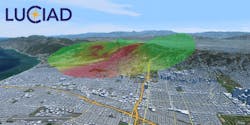NVIDIA launches GPU-accelerated platform for geospatial intelligence analysts to derive clear, actionable insights from mountains of surveillance data
SANTA CLARA, Calif., 17 July 2013. NVIDIA has launched a GPU (graphics processing unit)-accelerated platform to help geospatial intelligence (GeoInt) security analysts to find actionable insights quickly and accurately from vast quantities of raw data, images, and video: the NVIDIA GeoInt Accelerator.
The NVIDIA GeoInt Accelerator provides defense and homeland security analysts with tools that enable faster processing of high-resolution satellite imagery, facial recognition in surveillance video, combat mission planning using geographic information system (GIS) data, and object recognition in video collected by drones.
"Today's intelligence analyst needs information based on imagery, video, signals intelligence, human intelligence, and other sources, in a geospatial context and ‘at rate’,” recognizes Nick Buck, CEO of Buck Consulting Group and former IT executive with the NRO Ground Directorate. “The NVIDIA GeoInt Accelerator provides developers the opportunity to unleash the power of GPU computing to combine the variety and volume of data sources at the speed needed for mission support, enabling new levels of performance with minimal investment."
The complete solution includes: an NVIDIA Tesla GPU-accelerated hardware system, software applications for geospatial intelligence analysis, and advanced application development libraries.
Key applications in the NVIDIA GeoInt Accelerator include:
Luciad Lightspeed—Provides situational awareness for mission planning by overlaying image, radar, sensor data for line-of-sight analysis.
DigitalGlobe—Processes more than three million square kilometers of high-resolution imagery collected daily by satellites for current intelligence on points of interest.
GeoWeb 3D – Delivers native 3D GIS fusion – including LIDAR remote sensing technology and full motion video – without preprocessing.
IntuVision Panoptes— Provides object detection and event-driven alerts by processing multiple real-time HD video streams.
NerVve Technologies – Automatically detects objects in images and video streams.
The GeoInt Accelerator features a number of libraries that serve as building blocks for defense contractors and system integrators to build their own applications for GPU-accelerated image, video, and signal processing. These libraries and their contents include:
NVIDIA Performance Primitives – Basic image-processing kernels and functions.
Accelereyes ArrayFire – Image and signal-processing functions accelerated by GPUs.
MATLAB Imaging Toolkit – Imaging functions for high-level modeling in MATLAB.
OpenCV – Computer-vision functions.
NVIDIA CUDA FFT – For signal processing applications.
NVIDIA Optix – Programmable ray tracing framework to model stealth designs.
OpCoast SNEAK – RF propagation analysis, ray tracing, and jamming analysis development kit.
DelCross Savant – High-frequency ray tracing engine for antenna modeling.
NVIDIA GPU accelerators are already widely used in the defense industry for imaging, video, and signal processing by customers such as Army Research Labs, BAE Systems, Boeing, SAIC, NATO, NAVAIR, Northrop Grumman, Onera, Raytheon, and Thales Group.
Multiple deployment solutions are available from embedded GPU accelerators from GE Intelligent Platforms and Curtis-Wright, and workstations and server cluster solutions from major OEMs, including Dell, HP, and IBM.
Follow Avionics Intelligence news updates on Twitter (@Avionics_Intel), LinkedIn, and Google+.




